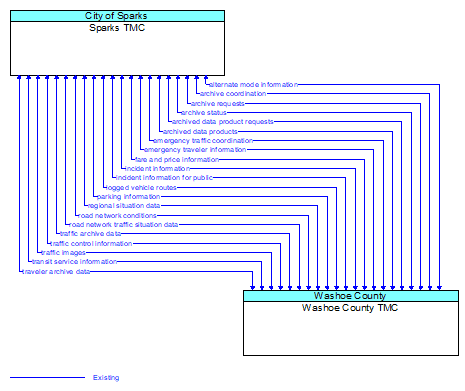Interface: Sparks TMC - Washoe County TMC

Architecture Flow Definitions
alternate mode information (Existing)
Schedule information for alternate mode transportation providers such as air, ferry, and passenger–carrying heavy rail.
archive coordination (Existing)
Catalog data, meta data, published data, and other information exchanged between archives to support data synchronization and satisfy user data requests.
archive requests (Existing) Applicable ITS Standards
A request to a data source for information on available data (i.e., "catalog") or a request that defines the data to be archived. The request can be a general subscription intended to initiate a continuous or regular data stream or a specific request intended to initiate a one–time response from the recipient.
archive status (Existing) Applicable ITS Standards
Notification that data provided to an archive contains erroneous, missing, or suspicious data or verification that the data provided appears valid. If an error has been detected, the offending data and the nature of the potential problem are identified.
archived data product requests (Existing) Applicable ITS Standards
A user–specified request for archived data products (i.e., data, meta data, or data catalogs). The request also includes information that is used to identify and authenticate the user and support electronic payment requirements, if any.
archived data products (Existing) Applicable ITS Standards
Raw or processed data, meta data, data catalogs and other data products provided to a user system upon request. The response may also include any associated transaction information.
emergency traffic coordination (Existing)
Coordination supporting disaster response including evacuation and reentry. Includes coordination of special traffic control strategies that support efficient evacuation and reentry while protecting and optimizing movement of response vehicles and other resources responding to the emergency.
emergency traveler information (Existing)
Public notification of an emergency such as a natural or man–made disaster, civil emergency, or child abduction. This flow also includes evacuation information including evacuation instructions, evacuation zones, recommended evacuation times, tailored evacuation routes and destinations, traffic and road conditions along the evacuation routes, traveler services and shelter information, and reentry times and instructions.
fare and price information (Existing) Applicable ITS Standards
Current transit, parking, and toll fee schedule information.
incident information (Existing)
Notification of existence of incident and expected severity, location, time and nature of incident. As additional information is gathered and the incident evolves, updated incident information is provided. Incidents include any event that impacts transportation system operation ranging from routine incidents (e.g., disabled vehicle at the side of the road) through large–scale natural or human–caused disasters that involve loss of life, injuries, extensive property damage, and multi–jurisdictional response. This also includes special events, closures, and other planned events that may impact the transportation system.
incident information for public (Existing) Applicable ITS Standards
Report of current desensitized incident information prepared for public dissemination.
logged vehicle routes (Existing) Applicable ITS Standards
Anticipated route information for guided vehicles, special vehicles (e.g., oversize vehicles) or groups of vehicles (e.g., governor's motorcade) that may require changes in traffic control strategy.
parking information (Existing)
General parking information and status, including current parking availability.
regional situation data (Existing) Applicable ITS Standards
This general flow represents the traffic, environmental, and emissions situation data that is collected from connected vehicles and aggregated, filtered, and distributed to other centers as a regional information product for use in operations, performance monitoring, and analysis.
road network conditions (Existing) Applicable ITS Standards
Current and forecasted traffic information, road and weather conditions, and other road network status. Either raw data, processed data, or some combination of both may be provided by this flow. Information on diversions and alternate routes, closures, and special traffic restrictions (lane/shoulder use, weight restrictions, width restrictions, HOV requirements) in effect is included.
road network traffic situation data (Existing) Applicable ITS Standards
Aggregated route usage, travel times, and other aggregated data collected from probe vehicles that can be used to estimate current traffic conditions.
traffic archive data (Existing) Applicable ITS Standards
Information describing the use and vehicle composition on transportation facilities and the traffic control strategies employed. Content may include a catalog of available information, the actual information to be archived, and associated meta data that describes the archived information.
traffic control information (Existing) Applicable ITS Standards
Represents the flow of traffic control and status information from a TMC to a third party TIC. This is reporting only, not actual control.
traffic images (Existing) Applicable ITS Standards
High fidelity, real–time traffic images suitable for surveillance monitoring by the operator or for use in machine vision applications. This flow includes the images and meta data that describes the images.
transit service information (Existing)
Transit service information including routes, schedules, and fare information as well as dynamic transit schedule adherence and transit vehicle location information.
traveler archive data (Existing) Applicable ITS Standards
Data associated with traveler information services including service requests, facility usage, rideshare, routing, and traveler payment transaction data. Content may include a catalog of available information, the actual information to be archived, and associated meta data that describes the archived information.